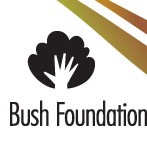 In an email message last Wednesday, The Bush Foundation announced the end of its existing Fellowship programs, including the Bush Artist Fellowships,  and the beginning of a new, single program which will be called the Bush Fellowship Program.  The new program’s aim is to “help people increase their capacity to work with others to improve their communities.”  Guidelines will be released December 1st.
In an email message last Wednesday, The Bush Foundation announced the end of its existing Fellowship programs, including the Bush Artist Fellowships,  and the beginning of a new, single program which will be called the Bush Fellowship Program.  The new program’s aim is to “help people increase their capacity to work with others to improve their communities.”  Guidelines will be released December 1st.
It’s interesting to look back on the Foundation’s Artist Fellowship guidelines and wonder who in our current professional philanthropic sector would launch such an artist support program today. Â The program was designed “to enable selected artists to devote concentrated time to their work and to increase the quality and pace of their artistic and career development, ” Â and was part of the Foundation’s overall aim “to establish and sustain an environment in which the arts can flourish.” Â An artist could use the Fellowship in many ways, “To engage in solitary work or reflection, for collaborative or community projects, or for travel or research.” Â Through a detailed application process, panels composed principally of working artists reviewed first preliminary and then final applications from several hundred artists per year. Â Final evaluation always included review of original work (actual paintings, for example, rather than slides of paintings). Â Artists selected (15 each year) received stipends of $50,000 (the amount of the fellowships increased over time). Â Panelists — all from outside the grantmaking region — also were well compensated for reviewing work samples and coming to St Paul to discuss applicants and select Fellows. Â Artists in Minnesota, North Dakota, South Dakota, and certain counties in western Wisconsin, were eligible to apply.
I worked at the Foundation from 1990-1999 and so my observations are biased. Â Here are some noteworthy things about the program that I remember.
– The Foundation’s internal evaluation process was sufficiently rigorous that regular evaluation studies were completed every few years to document and assess the impact of the Fellowships on both the individual recipients and on the broader community. Â These evaluation reports were widely disseminated and were influential in convincing other private foundations and public arts entities to establish artist support programs throughout the 1980’s and 1990’s. Â In these studies, artists repeatedly cited the life-changing impact the Fellowship had on their work; the reports detail rich, personal stories of how the fellowship time period was associated with generative changes in artists’ work, and they presented data about Fellows’ increased ability to support themselves through art making. Â As our field struggles with ways to document the impact of philanthropic dollars spent, these studies are well worth revisiting.
– The panel process was comprehensive.  Panels met for multiple days and had ample time to read aloud, view films, and otherwise deeply consider the work at hand.  Within these panel meetings, vocabularies and perceptions were expanded as we worked to find words to talk about what we were seeing, reading, and  hearing.  Lifelong friendships were formed, cross-pollination occurred, and careers were advanced, just through the selection process.
– The program had a documented effect on artists staying in the region and calling this place home. Â It helped establish the Twin Cities’ area, in particular, as a creative hotbed and a place where artists’ contributions were valued.
– Over many years the list of artists who’ve received Fellowships includes many who’ve gone on to be recognized through all manner of other awards and prizes. Â In no particular order, Fellows included August Wilson, Patricia Hampl, Â Jim Moore, Joann Verburg, Tom McGrath, Louis Jenkins, Lee Blessing, Kevin Kling, William Kent Krueger, Libby Larsen, Bart Schneider, Kathleen Norris, Wing Young Huie, Alec Soth, and so many, many artists who are nationally recognized and identified with this particular place.
The Bush Foundation has taken an instrumentalist turn with respect to its grantmaking in the cultural sector, focusing its efforts and dollars on large regional problems it is trying to solve, or at least make a dent in, over a ten-year period. Â In the context of its new strategic plan the Foundation is looking for Fellows whose work aligns with its own. Â If Bush sticks with this program for 35 years, as they have with the Artist Fellowship Program, I hope they have something with as significant and lasting a value as what the Artist Fellowships Program have had over time. Â In the meantime, it’s good to pause and reflect on what a terrific and long-term commitment the Foundation’s Board once made to the cultural sector and to individual artists, and the difference their grants made to so many of us whose lives are enriched by the work of Bush Artist Fellows.
